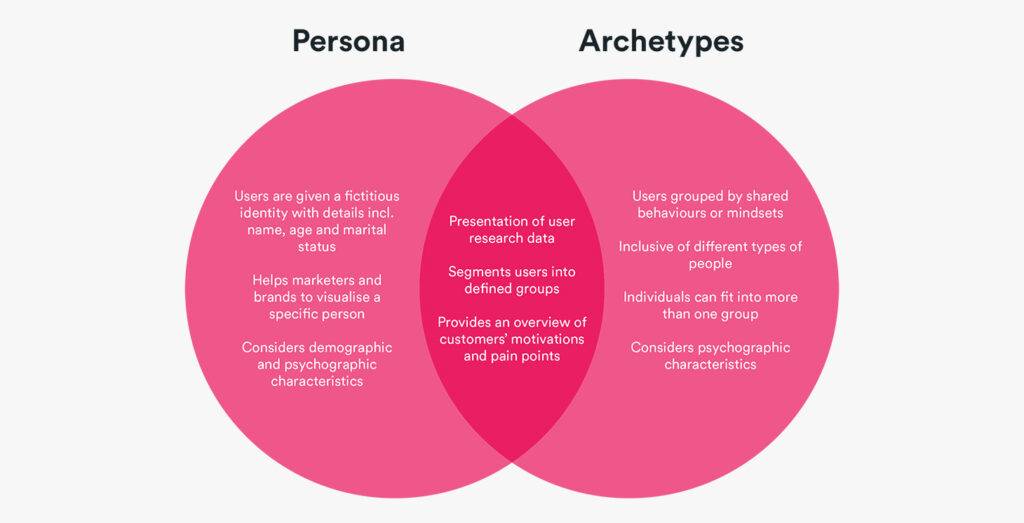Personas vs Archetypes
Personas
A user persona is a hypothetical personification of a certain type of user. They’re given a specific fictitious identity – a ‘persona’ – which can include a name, age, job title, location, and biography. For example: Charlotte, 29, South-East England, Primary School Teacher. Lives with her partner and young child. Enjoys finding local, family-friendly activities to do at the weekends but struggles for inspiration.
Archetypes
A user archetype groups users by shared behaviours or mindsets and may encompass several different types of people. Each archetype is unified by an overarching collective goal, such as making a purchase, finding contact details, or applying for jobs.

Deciding which approach is right for you
The concept of personas was first introduced back in the 1990s by American software designer Alan Cooper in his book ‘The Inmates Are Running the Asylum’. In it, he expressed the disconnect between those designing software vs. what users actually want and the role personas can play in building more useful software. It’s an approach that UX/UI designers and marketers have drawn on ever since.
Of the two, personas are the more traditional representation of audiences and essentially draws from what is known about the customer through data (e.g. Google Analytics) and consumer insights. The intent of personas is to provide as much detail as is useful to the organisation. With this said, they can be extremely granular and include factors like level of education, whether they have children, and out-of-work hobbies. Often, personas will go so far as to include imagined names and visual identities, giving brands a highly defined notion of who they’re targeting.
However, with that level of hyper-specificity comes a higher risk of excluding anyone who doesn’t fit into this character. With brands wanting to ensure they’re creating content that resonates with as much of their audience as possible, for this reason personas won’t always be the right fit.
This is where archetypes come in. Archetypes do away with specifics and instead cluster user types thematically through shared motivations and behaviours. In practice, this means that within one archetype, for example, “innovators”, you’ll usually find multiple groups of people unified by a broader goal. For example, for a B2B client one website may need to act as a resource for a wide sub-section of user types, ranging from graduates to investors and the media. Each of these archetypes will have its own requirements to gain from their visit to the site.
Are personas/archetypes actually useful?
Without a doubt – but only if you know why you’ve got them. Before you even carry out any data gathering, looking forward and thinking about what your personas or archetypes will feed into is key. Every element of your archetype or persona should add value by aiding in your decision-making. If it doesn’t, it doesn’t need to be there.
Keeping this in mind will ensure that what you produce will be of genuine use and can be used as a reference point by different teams and collaborators.
Beyond content
Typically, discussions around personas have predominantly been restricted to informing content strategies and UX/UI decisions.
- Digital PR
Before kicking off any campaign, our digital PR team conduct thorough research into the intended audience. After all, what use is a campaign if we don’t know who it’s for? This knowledge feeds into every stage of the campaign, from choosing assets to deciding which journalists to pitch to, and how. - SEO
For our SEO specialists, understanding the user’s intent and the tasks they’re trying to complete helps to build out keyword research. We’re able to select target terms based on what users are searching for and eliminate topics that we know aren’t relevant to them. It also allows for more tailored metadata, in turn boosting click-through rate and quality leads for a better ROI. - Data
Knowledge is power when it comes to data. Having clear audience personas to refer to can help data analysts to better understand user patterns and behaviours. In short, why are users doing what they’re doing? But it not only helps to contextualise historic behaviours – it can also feed into predicting future patterns, too.
Archetype/persona synergy is key
Understanding your audience is a strategic decision which connects multiple marketing channels.
If you’re wondering whether they could be beneficial for you, a good place to start is to ask ‘do we really know who our audience is?’. Now, often brands may think they know who their audience is – or who they’d like them to be – but the reality can be quite different.
Our content strategy team regularly work with our clients to help them find their target audience. Get in touch to discuss how this could help with aligning your marketing efforts, generating leads and creating a more engaged audience.
